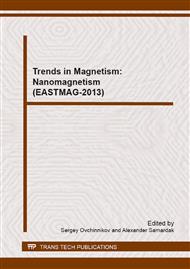p.298
p.309
p.314
p.320
p.325
p.331
p.337
p.342
p.348
Magnetoimpedance of Amorphous Ribbons with Polymer Covering
Abstract:
Magnetic properties and magnetoimpedance were studied for as-cast Fe5Co75Si4B16 rapidly quenched amorphous ribbons and Fe5Co75Si4B16/polymer amorphous ribbon based composites with the following polymer coverings: modified rubber solution in o-xylene, copolymer solution of butyl methacrylate and methacrylic acid in isopropanol and solution of polymethylphenyl resin in toluene. All selected composites showed very good adhesion of the coverings and allowed us to provide long term temperature measurements, including measurements under stress. Polymer coverings have an effect on the temperature sensitivity of the impedance value. The present study demonstrates the promising future for the development of magnetically active conductor/polymer composites for creating new sensors. Modification of the composition and thickness of the polymer coverings can be the basis for creation of the detectors with a unique set of functional properties. Polymer covering can perform the protective and reinforcing role that is particularly important in the case of nanocrystalline alloys and the polymer covering can also affect and improve the functional properties of the magnetic core.
Info:
Periodical:
Pages:
325-330
Citation:
Online since:
April 2014
Price:
Сopyright:
© 2014 Trans Tech Publications Ltd. All Rights Reserved
Share:
Citation:


